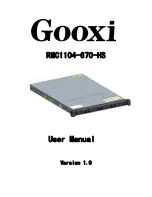
Step 4: Connect Cables
■
Required Tools and Wires for Cabling on page 9
■
Connect the Management Console on page 9
■
Connect the Timing Port on page 10
■
Connect the Serial Interface Module on page 10
■
Connect the T1/E1 Interface Module on page 10
Required Tools and Wires for Cabling
Cabling your device takes only a few minutes. You need the following items for
proper installation:
■
1/8-inch flathead screwdriver.
■
3/8-inch wrench or 3/8-inch nut-driver.
■
No. 2 Phillips screwdriver.
■
Ground wires—We recommend a minimum of 18-AWG ground wire for AC and
DC-powered versions, if applicable.
■
Two #10 kep nuts (supplied) to connect the ground (earth) wire to the ground
terminal.
■
Power module wiring—We recommend a minimum of 18-AWG wire for the
device with a dual stud terminal lug with 5/8-inch spacing.
Consider the distance from the connection point and the configuration of the device
when determining the size of wire used.
Connect the Management Console
The
CONSOLE
port on the front of the chassis of the CTP150 platform is for
management access (see Figure 1 on page 7). The 10/100Base-T Ethernet port
accepts a male RJ-45 connector, providing an out-of-band connection for LAN access
through an SSH session or SNMP.
The
CONSOLE
port is considered a data terminal equipment (DTE) interface. Direct
connection to a terminal or PC (which also has a DTE interface) requires a crossover
cable.
To connect the device to the network:
1.
Insert an RJ-45 Ethernet cable connector into the
CONSOLE
port until it clicks
into place.
2.
Connect the other end of the cable to the appropriate Ethernet network for an
out-of-band connection.
Step 4: Connect Cables
■
9
Step 4: Connect Cables








































